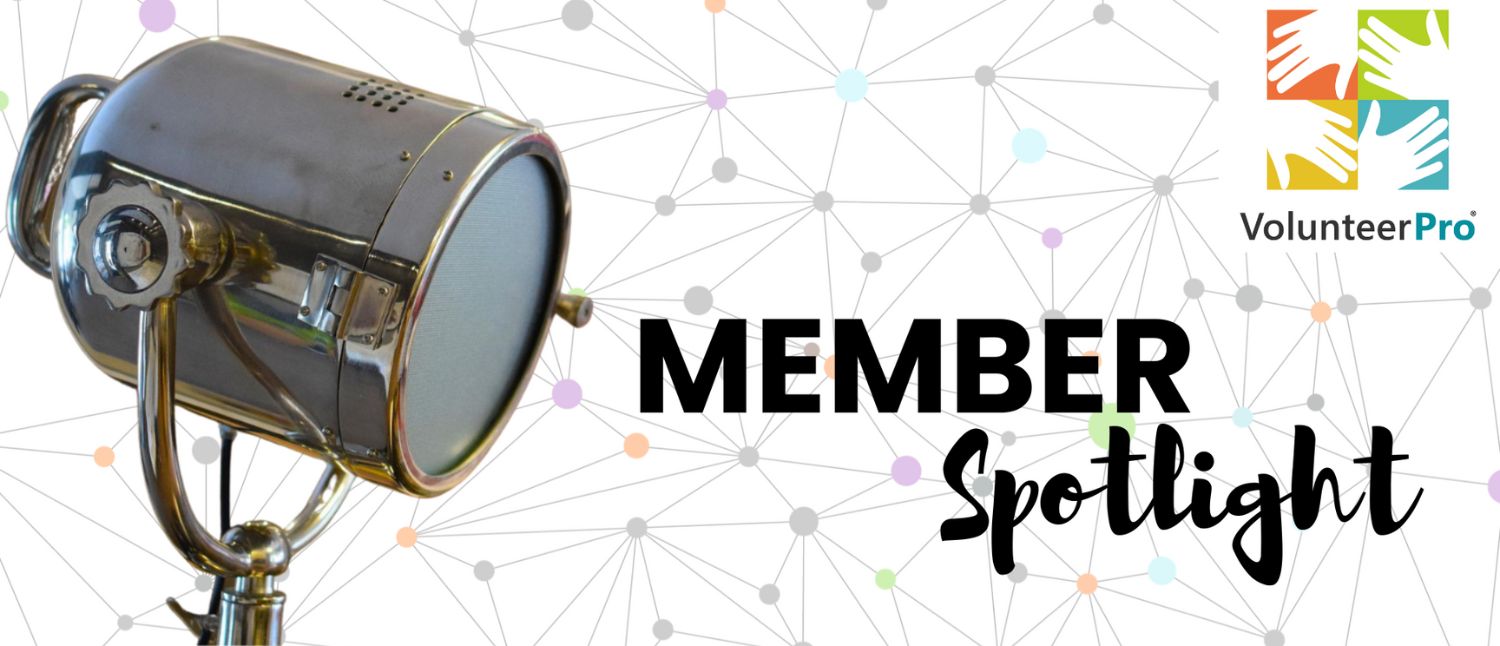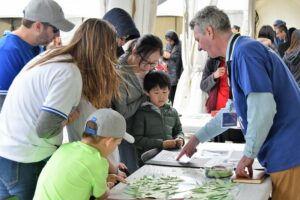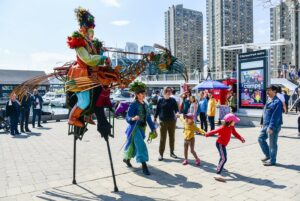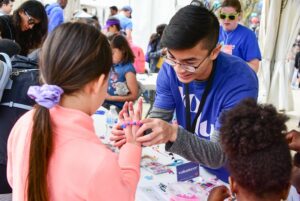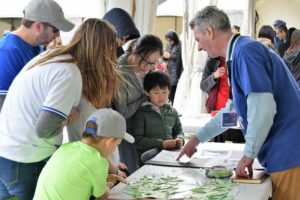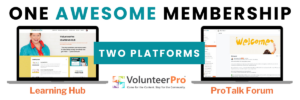Member Spotlight: Embracing Diversity, Equity, and Inclusion Through Volunteer Service
This month, we sit down with VolunteerPro member Saskia Rinkoff to discuss some fresh ways her organization is embracing diversity, equity, and inclusion through “Sight Guide” volunteers, and how those efforts are making the arts more accessible to a larger audience.
Chelsey: Hi Saskia! Tell me a little bit about your organization.
Saskia: Harbourfront Centre is a charitable, not-for-profit contemporary arts and culture organization on Toronto’s waterfront. Across 10 acres of land along the beautiful lakeshore, we animate multiple outdoor and indoor spaces year-round with contemporary arts and culture events.
We program literary arts, performing arts, music, dance, theatre, visual arts and craft & design events. In addition, we have a School and Camps program. The events and festivals are produced in-house or co-presented with our partners.
Chelsey: What do your volunteers do to make an impact?
Saskia: Our volunteers support most departments and festivals. There is never a dull moment! For instance, Harbourfront Centre’s Cultural Engagement (CE) team is responsible for programming most festivals.
Before each festival, volunteers might help the office with administrative tasks, such as mailouts, data entry, and inventory, or prepare materials for art activities and site decor. Volunteers might assist with lineups, wayfinding, scanning tickets or making crafts with kids and their families during festivals.
Sometimes, they help people with “curb to seat” seating, applying the sighted guide techniques they have been learning over the last few years.
Serving the Community through “Sighted Guide” Volunteers
Chelsey: Nice. Tell me a little about your volunteers’ techniques when guiding patrons from the curb to their seats. I am interested to see how that was created and rolled out.
Saskia: In 2022, the Cultural Engagement team collaborated with Alex Bulmer, a blind artist, writer and producer. Alex curated a program called CoMotion, a festival dedicated to disability arts, presented at Harbourfront Centre.
This meant that we had to have particular training for volunteers so that they could support community members and assist them with their different needs. This training included recommendations on guiding a person with low or no vision from their point of arrival to any on-site venue.
Alex worked with Rachel Marks, who specializes in this type of training, and with our teams at Harbourfront Centre to develop training to be presented to staff and volunteers.
The training taught techniques of how to introduce yourself, establish contact and let the person know that you can take them from point A to point B, and how to walk them from this location to the venue, all the way to their seat. It’s been a fantastic experience!
Looking for additional ways to make your organization more inclusive and equitable? Check out a list of Our Favorite DEI Resources for Nonprofits HERE>>
Chelsey: It is beautiful that everyone can enjoy and experience the arts without reservation because they need support. How did you identify volunteers who would fit the sighted guide role well?
Saskia: We did a general call to the team and asked who would be interested in developing those skills. The sighted guide technique is a transferable skill you can apply to encounters outside of work and should be part of everyone’s diversity, equity and inclusion (DEI) education.
Being proactive, open-minded and willing to develop those skills to assist everyone is vital. About 30 to 40 people stepped up and said they would like to participate in this training. Some of them already had experiences from other festivals or their personal circumstances.
We had a separate training session in our office led by Rachel Marks and Alex Bulmer. We practiced the sighted guide technique on each other. One person would request the “curb to seat” service as the visitor, and the other would offer the service.
When we practiced, we could develop a certain comfort level in speaking with the individual, how to introduce ourselves, how to make known that we are in their presence, and how to guide them to their seat physically.
Chelsey: I like that your volunteers are getting this type of exposure, so even if they are not assisting someone, they might be able to be more dialed in with others’ needs.
Overcoming Challenges with Planning and Patience
Chelsey: What is your biggest challenge right now in your program?
Saskia: Time. We are still coming out of the pandemic or working with the pandemic in a different setting. Now that we are returning to live events, we want to bring as many visitors, volunteers and participants back to the site as possible.
As you know, preparing for new situations takes time, rebuilding training and figuring out how to onboard people. There is a lot to take care of. You have to be flexible and adaptable and try to manage it all with your time.
Chelsey: Are you working on any projects?
Saskia: I’m working on two projects that are still under development. The first is looking at facilitating a cultural exchange for arts and artistic volunteers across the Nordic Region and other parts of the world.
The idea is to establish groups of volunteers interested in one of the arts genres. For example, film, literature or theatre. They would converse with volunteers in other parts of the world about their volunteer experiences before and during the pandemic.
The exchange should include reflections on how the pandemic affected them, how it has changed their knowledge, and how they hope to move forward. We often explore this topic from the perspective of the volunteer management professional but not as much from the volunteer’s point of view.
The other project I want to present during National Volunteer Week is dedicated to team leaders. I want to celebrate them, mainly because they are often more responsible. The event could include Indigenous learning.
We have an app in Toronto called First Story. The Native Community Centre Toronto (NCCT) offers historical tours that allow (non-Indigenous) participants to learn more about the land they live and work on. The goal is to host a walk for team leaders so that they can learn more about Indigenous history on our site.
Chelsey: That is awesome. I love that you’re separating as the team leads, focusing on them, and leaning into their passion for arts and culture with this walk. That kind of experience will help them bond with each other and the organization. You have a lot of cool stuff going on and a lot of connections, which is terrific.
Flexibility, Curiosity, and an Open Mind
Saskia: I think that’s what makes me so passionate about volunteer engagement, that you can play around with so many ideas, connect the dots and do crossovers, that it doesn’t have to be one neatly packaged task that needs to be completed, like having a front of house volunteer click attendance and handing out programs. It can be broader learning that could be beneficial for everyone.
Chelsey: What would you tell a new person to volunteer management? What kind of sage advice would you give them?
Saskia: Wow. It is crucial to have an open mind and be curious. The sector changes constantly, so you must remain flexible and adapt to new situations. Enter the field with an open heart and an open mind.
Chelsey: That’s good advice. What would you tell someone thinking about joining VolunteerPro?
Saskia: It’s been amazing. It’s so great to have that connection. You benefit not only from Tobi’s expertise but also from the community that is active within Volunteer Pro. It’s so stimulating and invigorating.
You are not alone in this. It’s a team of people with a wealth of knowledge, and everybody is willing to share and participate in conversations. I highly recommend it to anyone eager to learn more about volunteer engagement.
One of Harbourfront Centre’s volunteers brought VolunteerPro to my attention. Tobi hosted one of the free webinars. That’s what prompted me to join.
Chelsey: For a fun question, what are you reading right now?
Saskia: I’m reading a book for the Volunteer Management Professionals of Canada book club. We are reading Transforming Disruption to Impact by Beth Steinhorn and Jerome Tennille.
Check out our interview with the authors of the book From Volunteer Disruption to Impact with Beth Steinhorn and Jerome Tennille HERE>>
Chelsey: Tobi interviewed them recently on the Volunteer Nation Podcast!
Saskia: I would recommend the book to everyone.
I look forward to springtime, so I can go back outside and toil in our backyard. I enjoy being outdoors, seeing the plants grow and sitting in the backyard with a book or family and friends. I also love to hike.
Chelsey: Well, Saskia, chatting with you has been a pleasure. After every Member Spotlight, I always leave enthused and excited about what is happening in volunteer management. Thank you for all the work you are doing and for inspiring me and all of our blog readers!
Saskia: Thank you for allowing me to share my thoughts and ideas.
Join Us On the Inside as a VolunteerPro Member!
Join a great community of like-minded volunteer leaders as a VolunteerPro Member! VolPro membership helps you build or renovate an effective, what’s-working-now volunteer program with less stress and more joy, so you can ditch the overwhelm and confidently carry your vision forward.
It is the only implementation program of its kind and helps your organization build maturity across five phases of our proprietary system, the Volunteer Strategy Success PathTM.
Within membership, you’ll find in-depth training on how to build an effective recruitment and retention strategy, to attract and engage supporters in your good works. You’ll also have access to monthly coaching calls to ask questions and get feedback on your campaign design.
Membership includes access to a huge digital library of what-works-now content, live monthly seminars, workshops, and coaching calls, as well as a vibrant community of volunteer leaders to share ideas and questions.
Enrollment for new members is open NOW.

